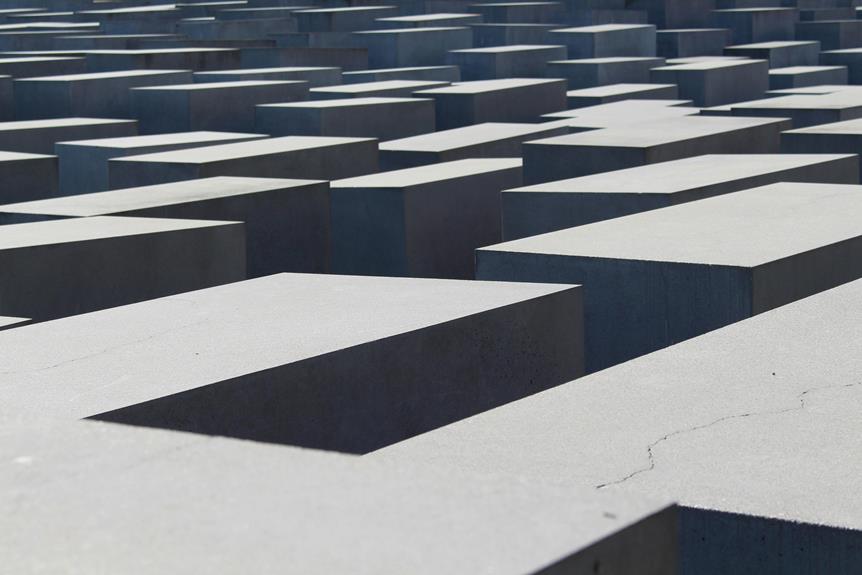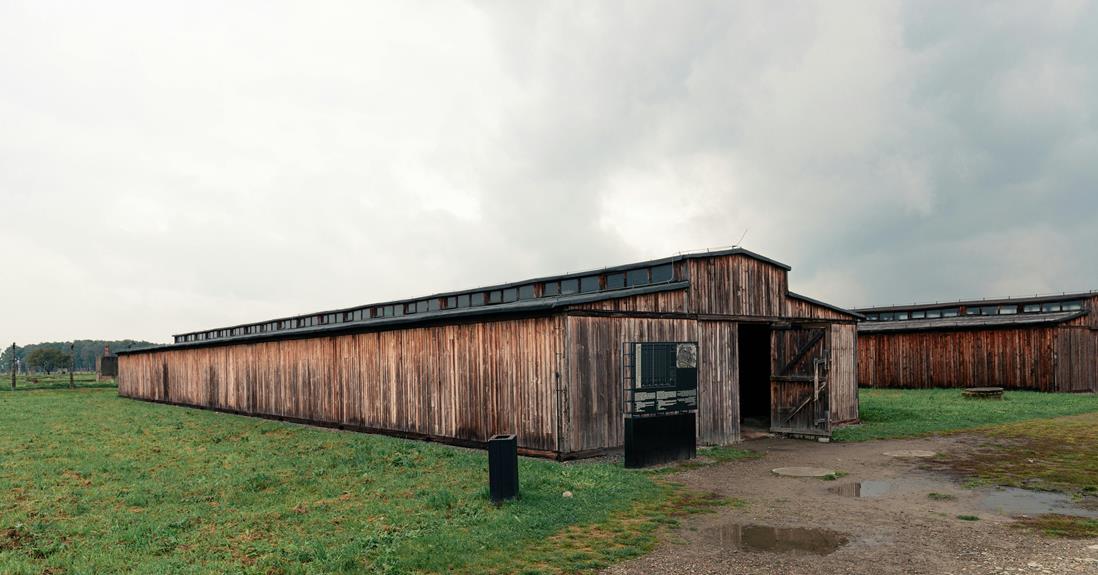The history of concentration camps is a somber chapter in humanity's narrative, marked by profound suffering and unfathomable atrocities. As we examine the origins, conditions, and purpose of these camps, we are confronted with the harrowing realities of oppression and abuse that occurred within their confines. From acts of resistance to the psychological scars borne by survivors, the legacy of concentration camps demands thoughtful reflection and a commitment to understanding the complexities of their impact on individuals and societies. To truly comprehend the depths of this dark history, we must explore not just the facts and figures but also the human stories that illuminate the resilience and tragedy intertwined within these institutions.
Key Takeaways
- Origins in late 19th century for mass detainment and political suppression.
- Notorious for neglect, brutality, and inhumane living conditions.
- Used by authoritarian regimes to oppress dissent and consolidate power.
- Symbolic of human rights violations and atrocities, notably during the Holocaust.
- Serve as tools for propaganda, control, and targeting threats to regime authority.
Origins of Concentration Camps
The establishment of concentration camps can be traced back to the late 19th century, with their origins rooted in the practice of detaining individuals en masse for various political, military, or social reasons. Initially conceived as a political strategy to suppress dissent and control populations, these camps evolved into symbols of gross violations of human rights.
Political strategy played a significant role in the development of concentration camps. Governments, particularly authoritarian regimes, used these camps as tools to consolidate power, silence opposition, and instill fear in the populace. By detaining individuals without due process or trial, authorities could suppress dissent and maintain control over their citizens. The arbitrary nature of internment in these camps often led to the persecution of marginalized groups, dissidents, and minorities, illustrating a blatant disregard for fundamental human rights.
The establishment and proliferation of concentration camps underscored a dark chapter in history where governments prioritized control and coercion over the protection of human rights. The systematic abuse and mistreatment of individuals within these camps highlighted the dangers of unchecked power and the erosion of basic freedoms. Understanding the origins of concentration camps is essential in recognizing the dangers of authoritarianism and the importance of upholding human rights in society.
Conditions and Treatment of Inmates
Amidst the grim reality of concentration camps, the living conditions and treatment of inmates were characterized by abhorrent neglect and systematic brutality. In these camps, inmates faced unimaginable horrors that stripped them of their dignity and humanity. Inmate experiences were marked by overcrowded and unsanitary living conditions, with inadequate food, clothing, and shelter. The barracks were often cramped, filthy, and infested with disease and vermin, leading to widespread illness and suffering among the inmates.
Furthermore, inmates were subjected to relentless physical and psychological abuse by the camp guards and authorities. Beatings, torture, and executions were common forms of punishment for even minor infractions, instilling fear and helplessness among the inmates. The systematic brutality aimed to dehumanize and demoralize the prisoners, breaking their spirits and will to resist.
In addition to the physical hardships, inmates endured profound emotional trauma from the constant fear, uncertainty, and loss they experienced in the camps. Many inmates witnessed the deaths of their fellow prisoners, friends, and even family members, further deepening their psychological scars.
Purpose and Function of Camps
Within the framework of totalitarian regimes, concentration camps served as instruments of oppression and control, designed to systematically target and eliminate perceived threats to the regime's authority. The purpose and function of these camps were pivotal, combining elements of camp administration, logistics, propaganda, and manipulation to achieve their sinister objectives.
Camp administration and logistics played a vital role in the efficient operation of concentration camps. These facilities were meticulously organized to strip individuals of their rights, dignity, and humanity. From the moment of arrival, inmates were subjected to a dehumanizing process of registration, categorization, and forced labor assignments. This systematic dehumanization was intended to break the spirit of the inmates and render them compliant with the camp authorities' demands.
Moreover, concentration camps were used as tools for propaganda and manipulation. The regime employed these camps to instill fear in the population, sending a clear message that dissent or opposition would not be tolerated. By publicizing the existence of these camps and the harsh treatment of inmates, the regime sought to deter any form of resistance and maintain control through intimidation.
In essence, the purpose and function of concentration camps were deeply intertwined with the regime's authoritarian agenda. Through a combination of camp administration, logistics, propaganda, and manipulation, these facilities became symbols of terror and oppression, serving to uphold the regime's power at the expense of basic human rights and freedoms.
Notable Concentration Camps in History
Notable throughout history for their chilling significance and impact, concentration camps have left a lasting imprint on the collective memory of humanity. These sites, synonymous with suffering and oppression, have been the stage for some of the darkest chapters in human history. Two of the most infamous concentration camps are Auschwitz in Poland and Dachau in Germany.
| Concentration Camp | Location |
|---|---|
| Auschwitz | Poland |
| Dachau | Germany |
Auschwitz, a complex of over 40 concentration and extermination camps operated by the Nazis during World War II, is a haunting symbol of the Holocaust. It is estimated that around 1.1 million people, mostly Jews, were killed at Auschwitz. Dachau, one of the first Nazi concentration camps, set the blueprint for many others that followed. It became a training center for SS concentration camp guards and the site of medical experiments on inmates.
These camps not only serve as a grim reminder of the atrocities committed within their barbed wire fences but also as a tribute to the resilience of Holocaust survivors who managed to endure and bear witness to the unspeakable horrors and war crimes that took place within.
Resistance and Revolts Within Camps
Resistance and revolts by prisoners within concentration camps during World War II played a significant role in challenging the oppressive regime and asserting a semblance of defiance in the face of unimaginable adversity. In the darkest corners of these camps, where fear and despair reigned, acts of resistance emerged as a beacon of hope for many. Prisoners devised various revolt strategies to combat the systematic dehumanization inflicted upon them by their captors.
One prevalent form of resistance was the establishment of underground networks within the camps. These networks served as channels for communication, sharing crucial information, and coordinating acts of defiance. Through secret meetings and coded messages, prisoners were able to organize themselves, maintain a sense of unity, and plan revolts against their oppressors.
Revolt strategies within the camps ranged from small-scale acts of sabotage to large-scale uprisings. In some instances, prisoners risked their lives to destroy equipment, disrupt operations, and hinder the machinery of the camp. These acts not only provided a temporary respite from the harsh conditions but also served as a symbolic gesture of resistance against the tyranny that sought to crush their spirits.
Despite facing overwhelming odds, the resilience and courage displayed by those who resisted within the concentration camps stand as a tribute to the indomitable human spirit in the face of unimaginable atrocities.
Liberation and Aftermath
The liberation of concentration camps at the end of World War II marked a pivotal moment in history, yet it also ushered in a complex and challenging aftermath that would reverberate for years to come. As survivors emerged from the horrors of the camps, they faced significant reintegration challenges into a world that had been forever altered by the atrocities of the Holocaust. The aftermath of liberation brought to light the following key points:
- Physical and Psychological Rehabilitation: Survivors required extensive medical care and emotional support to begin the process of healing from the traumas they had endured. Organizations and governments worked tirelessly to provide essential services to aid in their recovery.
- Search for Family and Identity: Many survivors were left without family or a sense of identity, leading to a profound search for lost relatives and a struggle to rebuild their lives while grappling with the loss of their past.
- Historical Documentation and Education: The liberation of the camps also highlighted the urgent need for historical documentation and education to safeguard that future generations would never forget the atrocities committed. Efforts were made to preserve the memory of the Holocaust through survivor testimonies, museums, and educational programs.
The aftermath of the liberation of concentration camps serves as a stark reminder of the resilience of the human spirit in the face of unimaginable suffering and the enduring importance of preserving the lessons of history for a future of freedom and tolerance.
Psychological Impact on Survivors
The psychological impact on survivors of concentration camps post-liberation has been a profound and enduring aspect of their lived experiences. Many survivors exhibit symptoms of Post-Traumatic Stress Disorder (PTSD), which can include intrusive memories, nightmares, hypervigilance, and emotional numbing. These symptoms often persist long after the physical scars have healed, affecting their daily lives and relationships.
Survivors of concentration camps also commonly experience survivor guilt, a deep sense of remorse for having survived when many others perished. This guilt can lead to feelings of worthlessness, self-blame, and a persistent belief that they do not deserve happiness or peace. Coping with survivor guilt can be a lifelong challenge, impacting the survivor's mental health and well-being.
Furthermore, the psychological impact of the atrocities witnessed and endured in concentration camps can result in survivors struggling with trust, intimacy, and a sense of safety. The trauma inflicted during their imprisonment can shape their worldview, leaving them with a profound sense of vulnerability and fear.
Understanding the psychological impact on survivors of concentration camps is essential in providing them with the support and care they need to heal. By acknowledging their experiences, offering therapeutic interventions, and fostering a compassionate environment, we can help survivors navigate the long-lasting effects of their trauma and work towards reclaiming their sense of self and agency.
Contemporary Views and Memorials
Contemporary perspectives on concentration camps and the establishment of memorials serve as vital reflections on the enduring legacy of these atrocities and their impact on collective memory. In today's world, the discussion surrounding concentration camps has evolved to encompass not only historical analysis but also contemporary views that shed light on the ongoing relevance of these dark chapters in human history.
- Contemporary Perspectives:
- Scholars, activists, and descendants of survivors offer diverse interpretations of the significance of concentration camps in the present day.
- The examination of power dynamics, human rights violations, and the roots of prejudice contributes to a deeper understanding of the lingering effects of these atrocities.
- Ongoing research and public discourse challenge traditional narratives, prompting a reevaluation of how these events are remembered and interpreted.
Memorialization efforts play a vital role in shaping how societies reckon with the past and honor the memory of those who suffered in concentration camps. These memorials serve as tangible reminders of the horrors that took place and aim to make certain that future generations never forget the atrocities committed.
As contemporary perspectives continue to evolve and memorialization efforts persist, the dialogue surrounding concentration camps remains a poignant reminder of the importance of confronting history, acknowledging the victims, and working towards a future free from such atrocities.
Lessons Learned for Future Generations
Drawing from the profound lessons of history, a pivotal examination of the enduring impact of concentration camps provides invaluable insights for guiding future generations towards a world devoid of such atrocities. The impactful remembrance of the horrors that occurred within these camps serves as a stark reminder of the consequences of unchecked power, prejudice, and discrimination. By studying the history of concentration camps, future generations can gain a deeper understanding of the fragility of human rights and the importance of upholding democratic values.
Educational resources play a pivotal role in ensuring that the lessons learned from concentration camps are not forgotten. Through school curricula, museums, and memorial sites, individuals can engage with primary sources and survivor testimonies, fostering empathy and a commitment to preventing such atrocities from occurring again. These resources provide a platform for critical reflection and dialogue, challenging individuals to confront the darkest aspects of human nature and inspiring them to work towards a more just and inclusive society.
Frequently Asked Questions
How Were Concentration Camps Disguised From the Public Eye?
Deceptive camouflage is a tool often utilized to shield undesirable realities from public view. Through strategic manipulation of information and appearances, unsavory practices can be hidden, allowing public ignorance to prevail.
This method is employed to maintain a facade of acceptability while concealing the true nature of the situation. Such tactics can perpetuate harmful activities by obscuring them from scrutiny, ultimately contributing to the perpetuation of injustice.
What Types of Medical Experiments Were Conducted on Inmates?
Medical experiments conducted on inmates during this dark period in history raise ethical implications and highlight the psychological effects of such atrocities.
These experiments, despite some leading to limited scientific advancements, were clear violations of basic human rights.
Analyzing the impact of these actions sheds light on the importance of upholding ethical standards in medical research, protecting individuals from exploitation, and ensuring that scientific progress is achieved with dignity and respect for human life.
Were Children Born in Concentration Camps Raised There?
Childhood trauma can have lasting effects on individuals, influencing their development and mental health. When children are raised in environments characterized by violence, fear, and deprivation, the impact can be profound and extend into adulthood.
Additionally, the generational impact of such trauma can affect not only the survivors but also their descendants, perpetuating cycles of suffering and psychological distress. Understanding the long-term consequences of childhood trauma is essential for providing appropriate support and interventions.
Did Any Prisoners Manage to Escape From the Camps?
Escaping the confines of oppression and captivity is a tribute to the indomitable human spirit.
Prisoner escapes from the camps were rare but not unheard of, with some brave individuals managing to defy all odds.
The survivors' stories of resilience and determination in the face of unimaginable horrors serve as a poignant reminder of the strength that lies within each human being, even in the darkest of times.
How Were the Bodies of Deceased Inmates Disposed Of?
In various historical contexts, the disposal of deceased individuals has been carried out through a range of burial practices and cremation methods. Understanding the cultural, religious, and logistical factors that influence these processes is vital for grasping the diverse approaches to handling human remains.
Burial practices can vary widely, from traditional ground burials to above-ground tombs, while cremation methods involve the use of high temperatures to reduce the body to ashes.
Conclusion
To sum up, the history of concentration camps serves as a stark reminder of the depths of human cruelty and oppression. The enduring legacy of these camps highlights the importance of vigilance against authoritarian regimes and the protection of human rights.
Just as the survivors of these camps have persevered through unimaginable trauma, so too must society continue to learn from the past and work towards a future free from such atrocities.


